Use Insights to track students' behavior with Web and YouTube analytics.
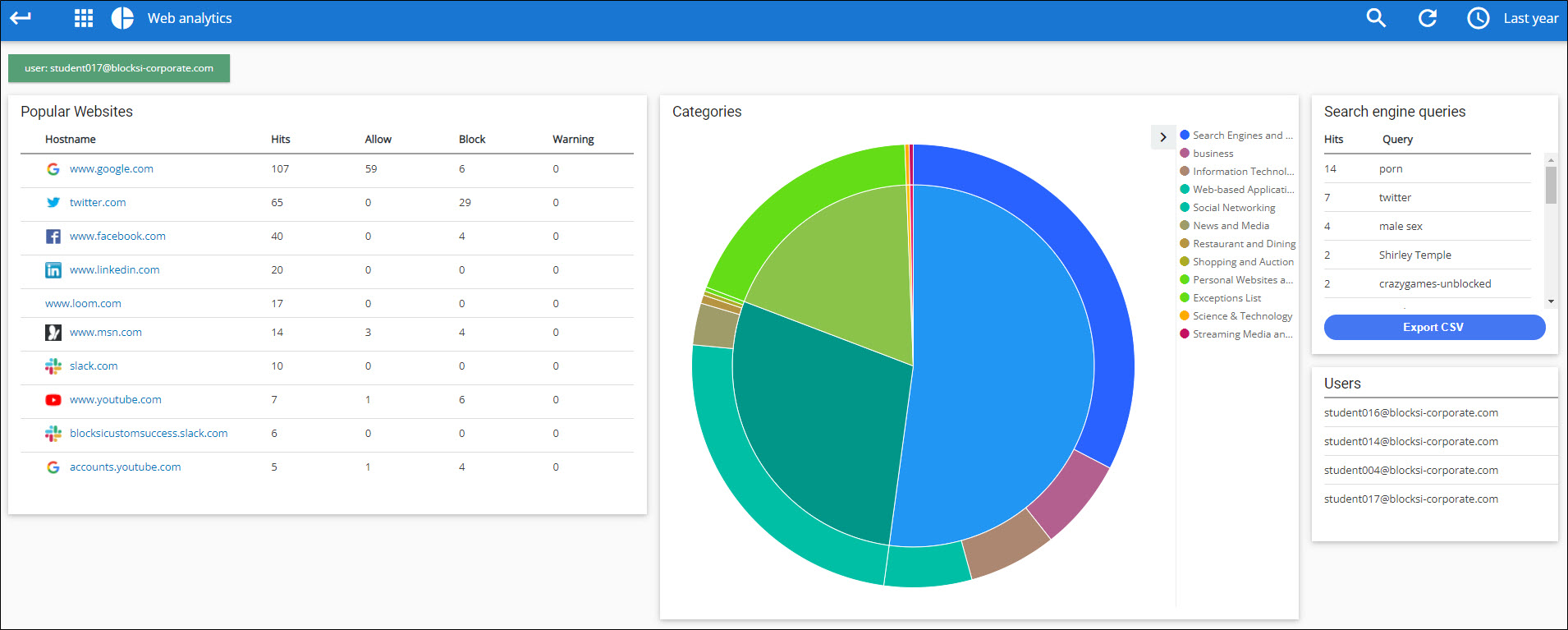
The Web Analytics screen gives you valuable information regarding the following:
Popular Websites - Gives the number of times the most popular websites were visited, including whether they were allowed, blocked, or provided a warning. Click each website name to go to that website.
Categories - Uses a pie chart to show the categories of the websites visited during the selected timeframe. Click each category to see the websites for that category. See Filtering Analytics for more information.
Search Engine Queries - Shows the terms used to search for website and the number of times each was searched for. Click each term to see which websites it was searched on. See Filtering Analytics for more information.
Users (Students) - Shows the students included in the selected timeframe and the number of hits each has. Click each user’s name to see the analytics for only that student. See Filtering Analytics for more information.
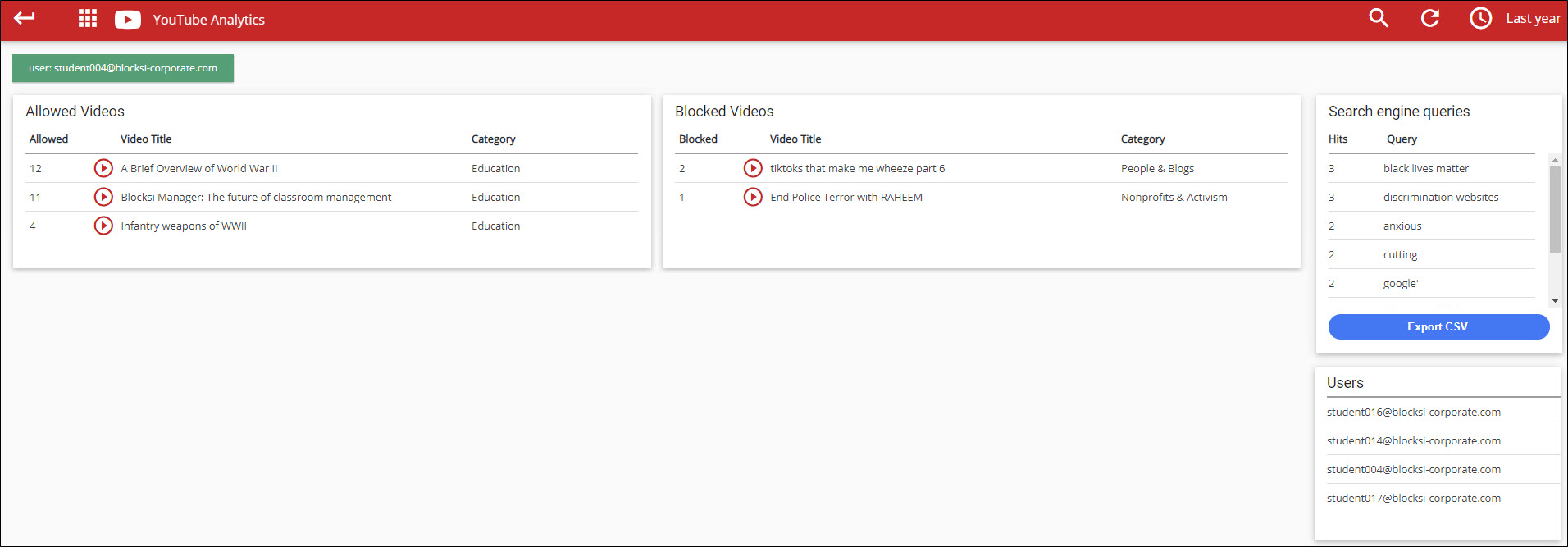
The YouTube Analytics screen gives you valuable information regarding the following:
Allowed Videos - Gives the names of the videos allowed during the selected timeframe.
Blocked Videos - Gives the names of the videos blocked during the selected timeframe.
Search Engine Queries - Shows the terms used to search for website and the number of times each was searched for. Click each term to see which websites it was searched on. See Filtering Analytics for more information.
Users (Students) - Shows the students included in the selected timeframe and the number of hits each has. Click each user’s name to see the analytics for only that student. See Filtering Analytics for more information.
Select the timeframe for which the web analytics apply.
To select the timeframe
Click Insights from the Main Menu. The Web Analytics screen appears. The timeframe is located at the far right of the blue area at the top of the screen. The default timeframe is Last 24 hours.
Click the timeframe to change it. The blue area expands to include a range of various timeframes, as shown below. The QUICK section includes preset timeframes. Click the CALENDAR section to choose the timeframe by month, week, and year, as shown to the right.

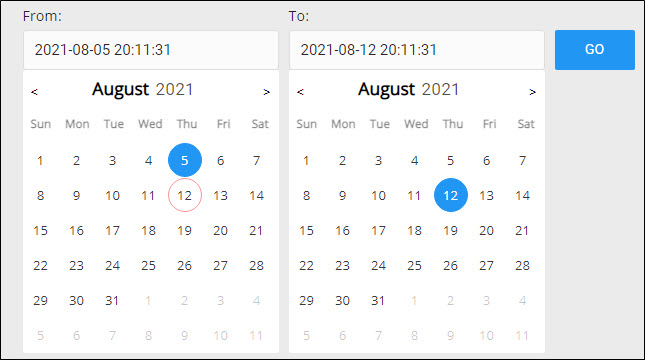
Click a timeframe to select it or select one from the calendar and click GO. The new timeframe appears at the far right of the blue area.
Create as many search filters as you need and use them to view specific analytics.
Note
When you access the Web or YouTube analytics page, the data is already filtered to your child. If you have added more than one child, data is filtered to the first child on your dashboard.
To access the filter
Click Insights from the Main Menuand then click the search icon at the top of the screen. The filter appears.
The following filters are available:
User - Search for a specific user’s browsing activity | Class - Search for a specific class |
Organizational unit - Search for a specific organizational unit | Teacher - Search for a specific teacher |
Action - Values supported are Allow, Block, and Warning | Location - Search for a specific location |
Category - Search for a specific web category | Policy - Search for a specific policy |
Hostname - Search for a specific hostname | WAN IP - Search for a specific WAN IP address |
Path - Search for a specific path | LAN IP - Search for a specific LAN IP address |
Search Engine Queries - Search for specific |
Note
You can use only one instance of each of these filters.
To use the filter
Select the filter to search on from the Filter drop-down list. When you select an option, the Name field and the Wildcard checkbox appear beneath the Filter list, as shown below.
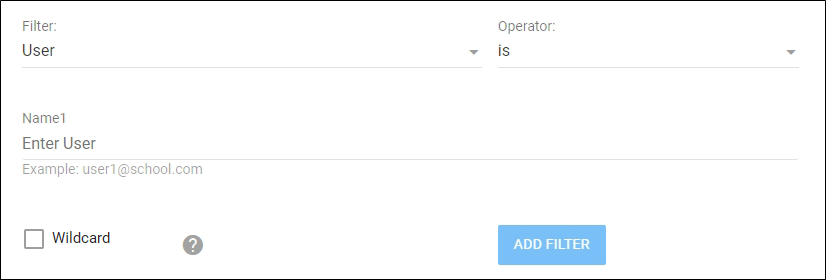
Note
The Wildcard checkbox appears only when you select any filter other than Action, Category, or Location
Note
Blocksi uses the asterisk (*) as a wildcard to represent one or more unknown characters in a URL. Example: "www.google.*" matches "www.google.com" and "www.google.co.uk."
Select the operator from the Operator drop-down list. The operator is used to restrict the search to a particular value. For instance: if you select User in the Filter list, is not in the Operator list, and type student002 in the Name field, the filter will restrict the search results to all students other than student002.
Note
If you select Action, Category, or Location as the filter and is one of or is not one of as the operator, checkboxes appear to the right of each filter when you place your cursor in the Name field.
Type the item to search for in the Name field.
Select the Wildcard checkbox if you include wildcards in your search. Selecting the checkbox is required if you use wildcards in your search.
Tip
The filter appears in red if you choose is not or is not one of operators; otherwise, the filter appears in green.
When you add a filter, it appears in the upper left-hand corner of the screen, as shown below.

Two filters were added: one to show data for all blocked actions and one to show data for all classes except Calculus.
Note that when you hover your mouse cursor over a filter name, three buttons appear, as shown below.

Click the first button to disable the filter so that the analytics apply to all students. Click it again to enable it.
Click the second button to change the analytics to display everything except that filter. Note that the filter turns red to indicate that the analytics is excluding the filter. Click to again to display analytics for that filter.
Click the third button to remove the filter.
The analytics logs contain valuable information about the activity in your organizational unit.
To view the analytics logs
Click Insights from the Main Menu and then click Web Analytics from its sub-menu. The Web Analytics screen appears.
Click Web Analytics from the top of the screen. A menu appears beneath the title bar.
Click LOGS.
The logs provide you with the following information:
Timestamp - The date and time at which the action occurred.
Category - The category of the website or video that was accessed..
LAN IP - The LAN IP Address of the device.
Action - The action that was taken. Valid entrie are allow, block, and warn..
WAN IP - The WAN IP Address of the device.
Policy - The policy that was effective when the action occurred.
MAC ADDRESS - The MAC Address of the device.
Location - The location at which the action occurred. Valid entries are inschool and outschool.
User - The user who initiated the action.
Blocksi Version - The current version of the Blocksi extension installed on the user's device.
Org. Unit - The organizational unit in which the action occurred.
Teacher - The teacher of the class in which the action occurred.
URL - The URL of the website or video that was accessed.
Role - The role of the user who initiated the action.
Download the analytics report, which contains information about Web and YouTube analytics, in CSV or PDF format.
To download the analytics report
Click Insights from the Main Menu and then click Web Analytics at the top of the screen. A menu appears beneath the title bar.

Do one of the following:
Click DOWNLOAD PDF. The file appears in the lower left-hand corner of your screen in PDF format. Click it to open and save it.
Click LOGS. The Recent Logs screen appears. Click EXPORT CSV in the upper right-hand corner of the screen. The Export CSV window opens.
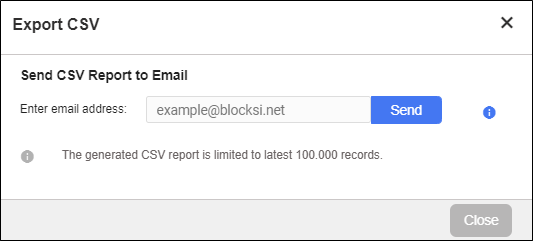
Type the email address in the text box and click Send. The CSV report is generated and sent to the email address you entered.